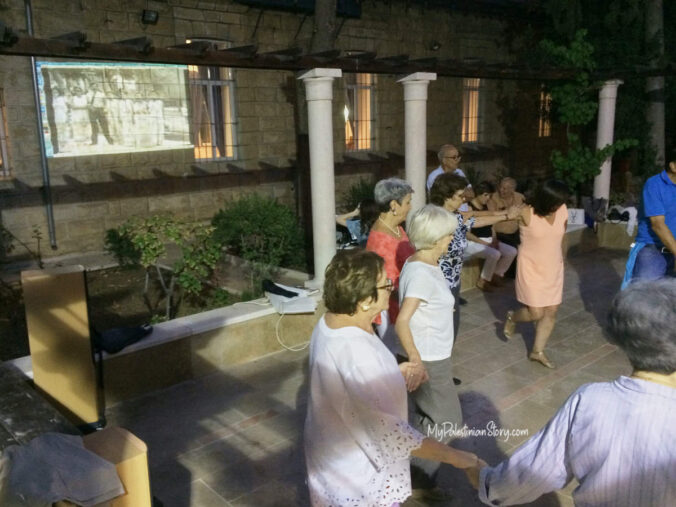When I became involved in the Katamon Project, I made available to them a series of short video clips I had extracted from a film that was part of great-uncle Nando’s (Ferdinand Schtakleff’s) extensive library. ‘Nando’ and ‘films’ are synonymous in our family’s parlance. Rarely was he to be found without a camera in hand. In his Jerusalem days, he even ran the Regent Cinema in the German Colony for a spell.
A copy of this particular film, labelled Jerusalem 1946-47, had been given to us in VHS which I then had transferred to DVD from which I extracted the individual short clips. The quality, as a result of all these transformations, is poor but the content, depicting as it does various aspects of our family’s life in Jerusalem, is simply precious.
In clip no. 7, nine young girls, in long, classical Grecian robes, are doing an ethereal dance—albeit a silent one, as the film has no sound—in the Greek Club. The Club (Λέσχη), located (predictably) in the Greek Colony, was the focal point of the Greek community’s life in Jerusalem and central to so many of our family stories. It survives to this day, having had its share of upheavals. (More details in later posts.)
Dancers: Feely Gaitanopoulou, Ellie Louisidou, Arty Melidou, Mary Melidou, Niovi Antoniadou, Ellie Spyridon, Zizi Karnapa. Two are unidentified.
The filmmaker, Nando, poses with the girls at the end.
These days, Greek dancing of a more contemporary form is taught on Tuesday evenings at the Club. On one such evening during my 2014 Jerusalem trip, Dorit arranged to have Nando’s film projected on the walls of the Greek Club while the dancing class was taking place. What made this arrangement particularly special was that one of my travel companions, Ellie Savvidou (née Louisidou) was one of the dancers in the film!
We received a warm welcome by the current head of the Greek Community, Anastas Damianos, who was thrilled to be hosting a member of the pre-1948 Greek Community, and eager to show us the results of his efforts to restore the Club to its previous glory. We were shown round and when the class got underway, Ellie and her daughter Evi jumped in.
As dusk fell, Dorit started the projection on the wall. The effect bordered on the surreal. The yellow stones of the Club wall became a screen on which those same stones were projected in black-and-white as the open-air dance floor behind us, now revamped, was reflected in the image of its older self. And although it’s safe to assume that the music in the film was quite different given the style of dancing, at times the live music synchronised with the celluloid dance in an almost eerie way.
During a break, Dorit spoke a few words to explain the provenance and history of the film and to introduce us—myself, the grand-niece of the filmmaker, and Ellie, one of the film’s… stars. The dancers, all of them Israeli except for the Greek teacher, listened with interest and afterwards approached Ellie with warm curiosity.
Then the dancing resumed—both on the real dance floor and on that projected on the wall. And Ellie, finding herself back in the Greek Club in Jerusalem, danced alongside her nearly 70-year younger image. ❖
Ellie is the one in white trousers,
holding the blue handkerchief with the teacher.

Leave a Reply